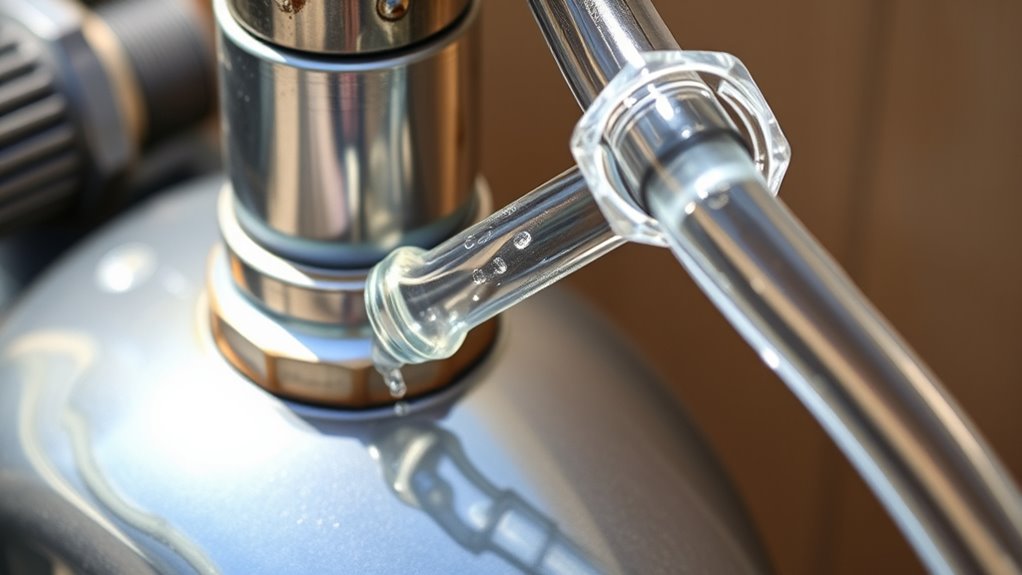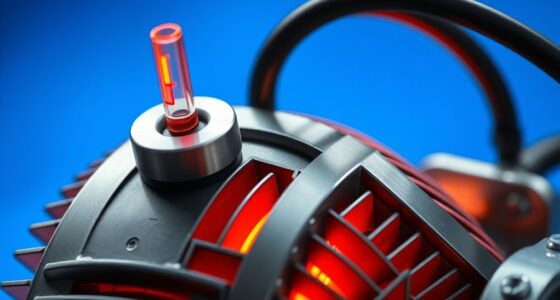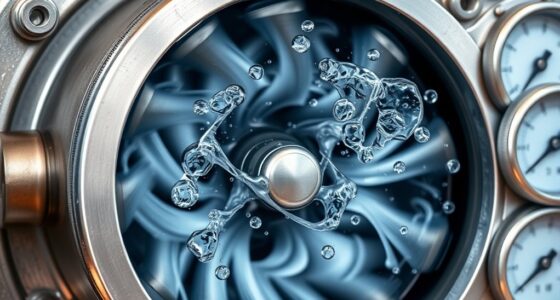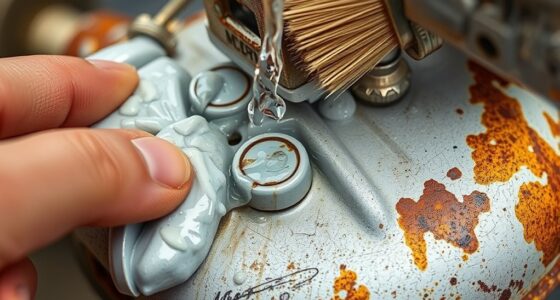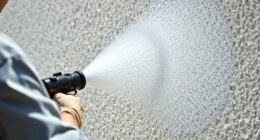If your pump won’t prime, check for air leaks in hoses or fittings, as these allow air to enter and break the vacuum. Make sure inlet and outlet valves are fully open and clear any debris blocking the intake. Verify the fluid source has enough fluid, and confirm the pump is positioned below the fluid level for better suction. Issues with seals or internal parts could also cause problems—keep exploring to find out more solutions.
Key Takeaways
- Air leaks in hoses or fittings prevent proper vacuum formation, hindering priming.
- Inlet or outlet valves that are partially closed or clogged restrict fluid flow and cause priming issues.
- Low fluid levels in the source tank reduce the pump’s ability to draw fluid effectively.
- Debris, dirt, or buildup inside intake components block fluid intake, impairing priming.
- Worn seals or internal component damage decrease suction power and prevent successful priming.
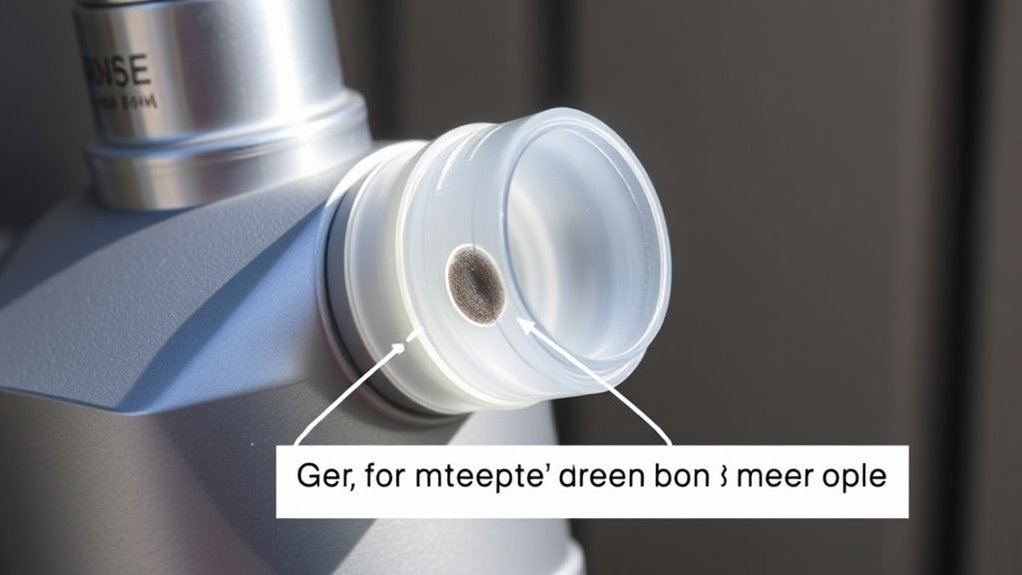
Have you ever experienced a vacuum or pump that just won’t pull properly? It can be frustrating, especially when you’re relying on it for essential tasks like draining a pool, transferring fluids, or maintaining a pressurized system. Usually, the problem isn’t with the pump itself but with what’s happening in the suction line. The issue often boils down to insufficient vacuum pressure, which prevents the pump from drawing fluid effectively. When that happens, it’s time to troubleshoot the common causes.
Experiencing weak pump suction? Check for air leaks, valve issues, or fluid levels to troubleshoot effectively.
First, check for air leaks. Even tiny cracks or loose fittings in the suction hose or connection points can let air enter the system, breaking the vacuum seal. You might notice bubbles or a hissing sound, which indicates air infiltration. Tightening fittings and replacing damaged hoses usually solves this. Next, examine the inlet and outlet valves. If they’re partially closed, clogged, or malfunctioning, they can restrict flow and prevent the pump from priming properly. Make sure these valves are fully open and functioning smoothly.
Another frequent culprit is the level of fluid in the source tank or reservoir. If the fluid level is too low, the pump might struggle to create enough suction to draw fluid up. Always verify that there’s enough fluid to prime the system effectively. Also, consider the position of the pump. If it’s located above the fluid level or on an uneven surface, it might be difficult for it to develop proper suction. Elevating the pump to a lower position or ensuring it’s on a stable, level surface can improve priming.
Additionally, check the intake for blockages. Debris, dirt, or buildup inside the inlet screen or strainer can restrict flow. Regular cleaning of these components helps maintain ideal suction. If your pump uses a gasket or seal, inspect it for damage or wear. A faulty seal can allow air in, compromising the vacuum. Replacing worn seals restores proper priming capability.
Sometimes, the issue isn’t mechanical but related to the pump’s internal components. Worn impellers or damaged seals can reduce suction power. If you’ve tried all the above and still face problems, it might be time to think about servicing or replacing the pump. Maintenance routines, like flushing the system and checking for leaks periodically, help prevent these issues from recurring.
Also, keep in mind that beneficial ingredients like collagen and hyaluronic acid are often used in eye patches for their hydrating and anti-aging properties, and while they are effective for skincare, similar nourishing agents are not used in pump systems.
Frequently Asked Questions
Can a Clogged Filter Cause Priming Issues?
Yes, a clogged filter can definitely cause priming issues. When the filter is blocked, it restricts water flow into the pump, making it difficult for the pump to draw in water and create the necessary suction. This lack of flow prevents the pump from reaching prime. To fix this, you should clean or replace the filter regularly, ensuring unobstructed water flow and proper priming of your pump.
How Does Altitude Affect Pump Priming?
Did you know that at higher altitudes, water boils at lower temperatures? This affects pump priming because the thinner air causes the atmospheric pressure to drop, making it harder for your pump to create a proper seal. As you ascend, you’ll notice it takes longer to prime your pump or it may fail entirely. To overcome this, you might need to adjust your priming method or install a pressure booster to compensate for altitude changes.
Is It Normal for a Pump to Lose Prime Over Time?
Yes, it’s normal for a pump to lose prime over time. You might notice it happens due to leaks in hoses or fittings, evaporation, or debris blocking the inlet. Regularly check for leaks, make sure the inlet is clean, and keep the pump’s seals in good condition. If you maintain these areas, you’ll reduce prime loss and keep your pump running efficiently longer.
Can Using the Wrong Type of Fluid Cause Priming Problems?
Yes, using the wrong type of fluid can cause priming problems. When you use an incompatible fluid, it may not flow properly or create the right seal needed for priming. Thick or viscous fluids can make it harder for the pump to draw in material, leading to air pockets or loss of prime. Always use the manufacturer-recommended fluids to guarantee your pump primes correctly and operates smoothly.
What Safety Precautions Should I Take When Troubleshooting Priming?
Think of troubleshooting your pump like steering through a minefield—you need to be cautious. Always unplug the power before inspecting, wear gloves to protect against sharp edges or chemicals, and avoid working near water or electrical sources simultaneously. Use proper tools and follow manufacturer instructions carefully. Venturing into the process unprepared risks shocks or damage. Stay alert, stay safe, and take your time to prevent accidents.
Conclusion
When your pump struggles to prime, it’s like a clogged throat choking the flow of water’s journey. Imagine trying to draw a breath through a blocked pipe—no matter how hard you try, nothing moves. Clearing those suction issues is like unclogging that pipe, allowing the water to surge freely, filling the space and flowing smoothly once again. Don’t let stubborn air pockets or leaks hold back your pump’s silent, steady rhythm.
